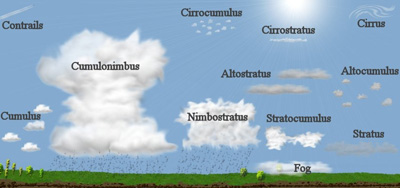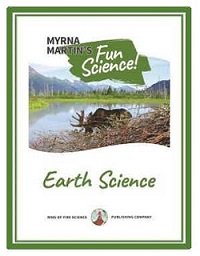Thunderstorm Clouds
Thunderstorm clouds form when warm air currents rise above the Earth’s surface creating cumulonimbus clouds. These clouds produce rain, lightning, hail and occasionally tornadoes.

Thunderstorm clouds
Thunderstorms form on warm sunny days when warm air currents rise above the Earth’s surface producing towering thunderstorm clouds that produce rain, lightning, hail and occasionally tornadoes. NOAA estimates that each year there are over fourteen million thunderstorms on our planet that means approximately 40,000 thunderstorms occur somewhere on Earth each day.
Formation of thunderstorm clouds (cumulonimbus)
Summertime often produces cumulus clouds as the warm surface of the Earth heats the air above land. The air expands as it heats up creating an updraft because the expanding air is lighter than the cooler denser that surrounds the rising currents of warm air. The rising air creates updrafts that move upward in the atmosphere where it first forms cumulus clouds.
The updrafts of warm air soon create towering thunderstorm clouds that typically reach 20,000 feet or more on warm sunny days. The air cools as it rises forming water droplets as the air condenses. The water in the clouds as it moves upwards begins to form tiny ice crystals. The water droplets and ice crystals are caught in the turbulent air rising and falling in the clouds.


Click for More Information and to Order
How lightning forms
The cooler air moves away from the updrafts and begins to fall toward the Earth because it is cooler and denser forming a circular motion of air with rising and falling currents. The tiny ice crystals in the upper parts of the cloud bump into each other building up positive charges of ions forming an electrical field in the upper parts of the cloud of static electricity.
The ice crystals that fall toward the Earth are stripped of some of their ions creating an electrical field of negative charges near the bottom of the clouds. When the two fields are large enough a bolt of lightning is generated between the two electrical fields moving them closer together. The thunderstorm clouds continues produce rain and lightning as long as updrafts continue to form beneath the clouds.
Cold and warm air masses collide
Cold fronts moving across the land sometimes collide with warm fronts that usually produce thunderstorms. The cold air mass is heavier and denser than the warm air in a warm front. The cold air pushes its way beneath the warm air forcing it to rapidly rise as the cold air pushes through an area. The air movement produces thunderstorms.
The Jet Stream is often associated with severe thunderstorms
The jet stream is a moving current of air near the tropopause. When a strong jet stream occurs it can push a line of thunderstorms 150 miles to 200 miles ahead of the cold front. When a line of thunderstorms are pushed ahead of the cold front by the jet stream it is called a squall line.
Thunderstorms always produce lightning
Most lightning produced by thunderstorms occurs inside a cloud. The lightning bolt reduces the number of positive and negative charges in the electrical fields in the clouds. When the lightning lights up the sky in a cloud it is called a sheet of lightning.
A buildup of positive charges on the ground can cause lightning to form between the lower areas of the thunderhead and the ground. The ground’s positive charge concentrates around anything that sticks up including trees, lightning conductors and even people. That is why you need to get to a safe place as quickly as possible when a thunderstorm is moving your way.
What causes thunder
A lightning bolt as it travels through the air is about 54,000° F which is about 6 times hotter than the surface of the Sun. When the bolt of lightning travels through the air it heats the surrounding air to about 50,000 degrees F. The rapid heating and cooling of the air creates a shock wave that results in thunder. Lightning strikes near you will sound like a sharp crack or bang. Further away lightning sounds like a continuous rumble.
Thunderstorm Safety
- If you can here thunder after a lightning strike it is close enough that you could be struck by lightning.
- Seek immediate shelter in a building with a roof if possible.
- If you are in the water get out immediately.
- If you are boating or fishing get to dry land as fast as possible.
- Seek shelter and do not stay on a playground, golf course or other wide open spaces.
- Stay away from tall structures such as trees, telephone poles, or flag poles.
- Do not resume outdoor activities until the last clap of thunder.
Severe thunderstorms warnings
Severe thunderstorms often produce hail, rain, and possibly tornadoes. Meteorologists studying thunderstorms and tornadoes use a variety instruments to help them predict the weather in your area. The warning time for tornadoes produced in severe thunderstorms in recent years has increased. Prior to 1950 most people living in Tornado Alley were not given any warning about a possible tornado in their area.
The time increased to about 7 minutes in the last half of the 20th Century. Today, the time has increased to about 15 minutes in some areas during some storms. Check for weather forecasts if you are in an area where a severe thunderstorm might occur because it may produce damaging winds, hail and tornadoes.
More Weather Links
Weather Facts: The weather affects our everyday lives throughout the year. Use the links on this page to learn about hurricanes, the Earths atmosphere layers, air pressure, lightning and thunderstorms.
Formation of hurricanes in North Pacific Ocean occurs in two basins. They are the two most active basins for cyclones to form on our planet. Meteorologist recognized the north eastern Pacific Ocean basin 1920s.
The Earths atmosphere layers are similar to the interior of the Earth. Find out about the four major layers of atmosphere that are separated by temperature.
What is air pressure? It is the weight of air molecules pressing down on the Earth. The pressure changes as you move upward into the atmosphere.
What causes lightning and what are the warning signs before lightning strikes? Find out on this fascinating page about lightning.
What are thunderstorm clouds and how do they form? Find out how severe thunderstorms produce rain, lightning, hail and occasionally tornadoes.
KIDS FUN Science Bookstore
Check out Myrna Martin's award winning textbooks, e-books, videos and rock sets. The Kids Fun Science Bookstore covers a wide range of earth science topics. Click here to browse.










